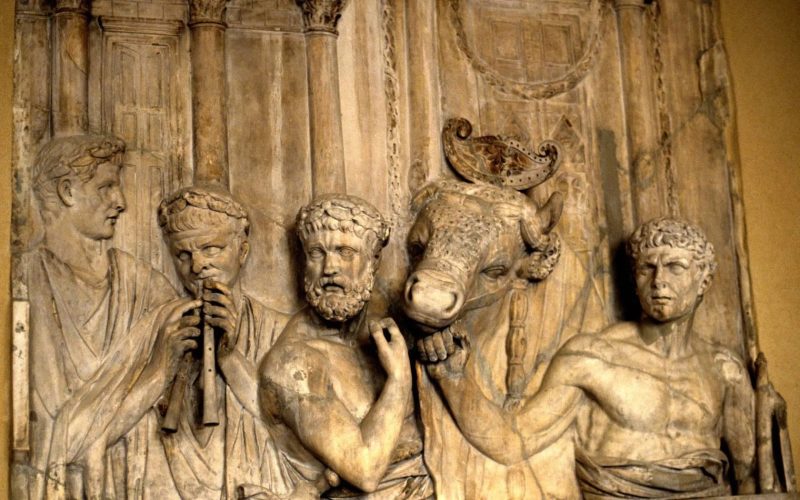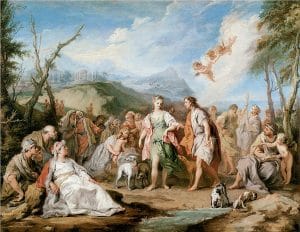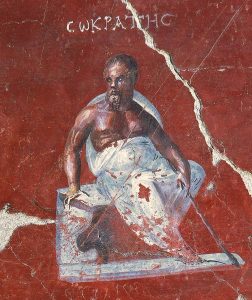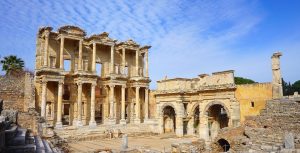Ephesus Temple
Blog Titles
ToggleEphesus Temple, Ephesus offerings votives, Ephesus altar
In the city of Ephesus, we will see both the temple culture, how the temples were, what architectural plan was used, what the altars in the temples were and what they were used for, as well as the most worship and offerings in the temples. B.C. As of the 6th century, you can see which animals were sacrificed for the sanctuary and votive in the ancient city of Ephesus, and the qualifications of the votive holder.
Ephesus Temple
In ancient Ephesus, people’s lives were in close relationship with gods and goddesses. Therefore, in almost every ancient city there was a center of belief created or dedicated to a particular god or goddess. Artemis was the belief center of Ephesus and the Ephesians living in the city of Ephesus, so Artemis was the chief goddess of Ephesus.
The area reserved for worship (cult) in the Temple of Artemis in Ephesus was called Temenos. The borders of Temenos were usually surrounded by walls. In the Temenos area, there was a temple believed to be inhabited by gods and goddesses, an altar on which votives were cut and burned to the island, and sometimes a treasure room at the back of the temple where items dedicated to the god and goddess were preserved.

The core of the Ephesus Artemis temple was the naos (cella). Because the statue of Artemis, which was worshiped, was located there. A peristyle (an open rectangular courtyard surrounded by columned corridors) was created by arranging columns around the naos and covering them.
Inantis (the type of temple with 2 columns between the cella side walls (ante walls) extending forward in Hellenic architecture), Prostylos (temple plan with columns on the front of the temple), and Amphiprostylos (a portico on both sides, that is, a temple plan in the style of a covered front with columns) type There are no peristyles in temples.
Peristyle, Peripteros (a type of building surrounded by columns), Dipteros (It is a temple shape surrounded by two rows of columns. The temple of Artemis in Ephesus is a temple with a Dipteros plan), Pseudodipteros (with the removal of its inner columns, which we call a false dipterous, a temple plan surrounded by external columns) planned seen in temples.
The temples made of stone and marble were first built in BC. It was started to be built in the 7th century. The Temple of Artemis in Ephesus is a temple built only of marble. B.C. Temples built before the 7th century were built of wood and adobe. In the Hellenic period, temples were built in Doric, Ionic, and Corinthian orders, based on their typology (column capital types) on column capitals.
The Temple of Artemis in Ephesus is a temple designed based on the Ionic column head. The temple of Artemis in Ephesus has a Dipteros plan and is covered with an arbor.
According to the historian Plinius, the Temple of Artemis in Ephesus was 220 x 425 feet wide (55 meters) and long (115 meters), had 127 columns (36 of them embossed), and the column height was 60 (18 meters). There were also temples of different styles in the ancient city of Ephesus.

These were built in the Olympieion Corinthian order in Ephesus, one is the temple of Serapis in Ephesus, the other is the temple of Hadrian in Ephesus, the other is the temple of Domitian in Ephesus, and the temple and sanctuary of the Emperor gods dedicated to the Roman emperors.
The style used in Ephesus is generally Ionic style buildings. In the Roman period, temples were built only in the Ion and Corinthian periods, and generally, Corinthian-style temples were built, except for the temple of Artemis. We know that the temple of Artemis in Ephesus had a Dipteros plan. The plan of the other temples and worship areas in the city of Ephesus is Peripteros.
In the plans of the Peripteros temple, the worship to be shown to the god was not done inside the temple, but outside the temple, walking around the temple. Periteros, dipterous, and pseudodipteros planned temples were made by walking around the temple in a peristyle (between columns and Naos).
Ephesus offerings votives
For worship, first, a sacrifice was made on the altar, then the priest in the front, the person who made a vow, the person who came for worship, those who played the flute or lyre behind them, and if the temple was without a peristyle, it was walked around.
Animal bones, most of which are described as food scraps, have been unearthed in the entire excavation area of Artemision. However, the most crucial role is played primarily by the layers of the older structures of the Croesus temple. Thus, most of the researched material is seen as organic residues of votive traditions that lasted until the Early Archaic period.
Most artifacts identified in the general narrative of the sanctuary have a wide variety, often with fine art objects, and are characterized by the socialization of large animal bones. This complex of finds contains ubiquitous (plant or animal) food scraps and accumulations of certain skeletal elements that have been selected and stored regularly.

These accumulations not only enable the identification of animal species, body parts, and slaughter age selected primarily by certain criteria but also distinguish them from conventional consumption residues due to the characteristic slaughter marks on them. Animal bones and other remains from the sacrificial rites indicate the existence of different ritual traditions within the sanctuary that are distinguishable from each other.
Although the Love votives, which are also described as “Olympic votives”, are easily seen as abundant food scraps there is no distinction between them and the profane (earthly) settlement residues in the appearance that emerges neither during assembly nor processing.
While charred animal bone fragments provide direct evidence of this votive tradition, they were found in abundance primarily in find-rich depots east and north of Hekatompedos (the Greek temple model with an appendage of 100 feet in cella’s length).
The remains of the Olympic Votive are manifested by the characteristic selection of burnt bones, as in the appropriate votive animals. To the extent that the white calcified fragments found in Artemision can be detected, often due to high-temperature burning, they belong almost exclusively to the femur – with a small amount – but also to the coccyx and coccyx.
While the proven species is concentrated in the small ruminant animals, which make up the majority, the distinction between sheep and goats, and cattle is very seldom possible due to the availability of finds.
Although the regular ritual burning of the thigh bone (Meria) of these votive animals, each time after the traditionally performed slaughter, is proven both by ancient sources and iconographically, as far as it can be seen, pigs were not preferred in this practice.
It is understood that the burning of the tails (Osphys) together with the tailbones may have been carried out first of all in cattle offerings. In addition, it is possible to come across clues about the votive character of this ceremony in a part of Aristophanes’ “Comedy of Peace”, which is a famous written source on this subject. The burning of Osphys in Artemision is evidenced above all by the pits (Bothros) dug into normal floors and used for different services.
While the remains of the pig sacrifice are fairly well attested in all the significant residual layers of the sanctuary, the results show that there are two very distinct ritual traditions.
The bones of young piglets, up to four months old, were found in the layers found at the excavation sites near Hekatompedos in the temple of Artemis. On the other hand, in its deeper layers, quite old and sometimes adult animal bones were found. The number of offspring of young pigs decreases with increasing digging depth.
The sign, which has a strong expression for the different cult uses of these two different age groups, is the remains of older animals, as well as the remains of small ruminant animals and cattle, leftovers from votive feasts. While it shows a lot of slaughter and slaughter marks, very rare postmortal, post-mortem slaughter marks are found on piglet bones.
Moreover, the dense upper surfaces of the usually consumed bones, shining like oil, indicate that the meat was fried or rather boiled. On the other hand, the soft tissue structure of piglets, which is like chalk, indicates that the animal’s body is rotten.
An interpretation of the small piglet remains found in clusters can be made with the help of archaeological finds made in the Temple of Artemis in Ephesus. In the area where the finds to the east and north of Hekatompedos are dense, a large number of water vessels (Hydria) and oil lamps were unearthed.
 It constitutes clear evidence of cult practices (Pannychid) performed at night to honor the gods and goddesses connected to the earth. Celebrations in this way, are probably BC. It gained importance in Artemision in the 6th century. Small piglets that were killed in large numbers should be seen about the ritual foldings made within the framework of Thesmophoria, an important celebration of women serving at night ceremonies away from the public’s gaze, mostly to honor the goddess Demeter and her daughter, the goddess Persephone (Korea).
It constitutes clear evidence of cult practices (Pannychid) performed at night to honor the gods and goddesses connected to the earth. Celebrations in this way, are probably BC. It gained importance in Artemision in the 6th century. Small piglets that were killed in large numbers should be seen about the ritual foldings made within the framework of Thesmophoria, an important celebration of women serving at night ceremonies away from the public’s gaze, mostly to honor the goddess Demeter and her daughter, the goddess Persephone (Korea).
At the center of the ritual was the storage of piglets and consecrated objects in an area called “Megara”, and beneath this area were underground pits or passages that could not be fully explained. During the tesmophoria feasts, the rotten remains of dead little piglets were taken out again and mixed with the seeds to be planted to increase the fertility of the fields.
Locust horns constitute an important group of large residual deposits due to their bone structure, namely horn cones. This archaeozoological visibility has emerged as a horned altar (Bomos Keratinos) in the temple of Artemis in Ephesus. It was determined that 49% of almost 2000 horn cob pieces belonged to the left side of the body and 51% belonged to the right side of the body.
In addition, it shows that the horns of the sacrificed horned animal were not separated as they should have been during the dissection, on the contrary, the horns were separated from the head in the form of a whole skull.
The prong form thus acquired is even more suitable than the smooth and sword-sheathed unicorns, as it forms a self-supporting altar-like structure. It shows a comparison of the experimentally detached skull of any goat, a suitable piece of artifact found in the sanctuary, and a small keraton reconstruction trial of several goat skulls tops from Artemision.
Ephesus Altar (Bomos)
It is the most important element forming the cult center. There are cult centers without temples, but there are no cult centers without altars, no temples without altars. It can be defined as a table where sacrifices are made and burned on the altar.
The altar in the temple of Artemis in Ephesus was placed directly opposite the entrance to the temple of Artemis. This enabled the cult statue of Artemis in the temple to see the slaughter and burning of the sacrificed animal on the altar.
As a rule, the meat of the animal dedicated to the gods was inedible by the devotee. After the animal was slaughtered, the fat part and internal organs of the sacrifice were burned, and comments were made on the acceptance of the god’s offering, his satisfaction or displeasure with it, according to the rise of the smoke to the sky. In addition, divination was made by looking at the smoke. The meat of the animal slaughtered as an offering was either left to the priest or distributed to the poor.
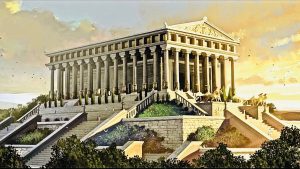
Sacrificial meats were eaten at festivals, feasts, and festivities, and their bones were burned. The person who made a vow and approached the temple to present his offering to the goddess Artemis had to be clean in body and spirit, and not be a murderer or a violent person.
Apart from the sacrifices dedicated to the goddess Artemis, large and small statues, three-legged cauldrons, war spoils captured by the enemies, 1/10 of the annual agricultural and trade incomes, jewelry, coins, dedications to the goddess Artemis by statesmen or private persons. They were presented as sanctuaries and they were preserved within the sanctuary. Such portable votive items were put into the inventory of the temple of Artemis. During John Turtle Wood‘s excavation of the Temple of Artemis, many inventory inscriptions of the temple of Artemis were unearthed.
Any Ephesian family head could perform the sacrificial ceremony in the temple of Artemis. However, there was always a priest or priestess who waited or guarded the temple of Artemis as well as other temples and arranged the religious ceremonies. This priest or priestess would help those who made sacrifices.
Temple priests or nuns in Ephesus were usually elected by the people’s assembly for a year or a lifetime. The duties of the priests and nuns were side by side. However, honor and chastity were at the forefront of the qualifications sought by the nuns who would work for the temple in Ephesus. Both the priests and nuns in Ephesus wore long clothes, grew their hair long, and carried scepters in their hands. In the ceremonies that lasted until midnight in the temples in Ephesus, they would appear with a wreath or band on their heads.
Temple priests or nuns in Ephesus were given a piece of sacrificial meat or sacrificial skin, sometimes even a little money, in return for their duties. Some of the meat of the sacrifice was given to the poor and beggars (Homolochoi).
While the rich people of Ephesus sacrificed votive animals such as calves, sheep, goats, and pigs, the poor sacrificed cheaper poultry. Ceremonies were carried out in a religious maturity. Only in festivals, festivities, and feast celebrations dances were performed within the borders of Temenos inside the temples.

